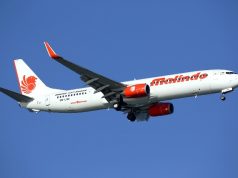KUALA LUMPUR, June 7 – Hybrid airline Malindo Air expects to carry more than three million passengers by the end of next year, contributed mainly by its aggressive network expansion plan.
Malindo Airways chief executive officer Chandran Rama Muthy said by the end of 2014, the hybrid carrier will be flying to almost all destinations it has in its plan — India, China and the Asean countries.
In an interview with Bernama, he said Malindo Air anticipates a fleet of 20 to 22 aircraft by end-2014, including turboprop aircraft to fly to destinations within Peninsular Malaysia.


“We began our operations in late March with Kota Kinabalu and Kuching. With those services, we have carried 125,000 passengers to-date.
“If within only three months we could achieve such a number, I am sure we will achieve our targets, assisted with all the plans we have in place.
“Further sales will also pour in as we keep on introducing new routes and adding frequencies. For now, about 50,000 people visit our website every day and purchase at least an air ticket,” he added.
The airline plans to expand to Sibu, Miri and Tawau in East Malaysia this month.
Chandran said the hybrid airline will be strengthening its domestic footprint before flying out of the country, with Singapore, India and China said to be among the first choices this year due to the immense untapped demand.
He said Malindo Air aims to position Malaysia as a perfect transit hub for travellers, as connectivity for travellers in the Asean region is very low.
“So far, we have only seen Bangkok and Singapore being regarded as transit hubs for the region. With Malindo Air playing its role, Malaysia will certainly be there too,” he added.
By the end of this year, Malindo Air expects to fly to Cochin, Trichy and New Delhi in India and Chinese routes such as Shenzhen and Shanghai.
In 2014, Chandran said, the hybrid carrier will be expanding its presence in India through new destinations namely Chennai, Mumbai and Calcutta.
“We are also exploring opportunities to fly to Guangzhou and Hong Kong. We are ready on our side. Regulatory approvals is the only barrier left.
“So far, we have received encouraging support from Malaysians and travellers at large. We have also taken in their feedback for better performance in future,” he said.
AirAsia X, the medium-haul affiliate of AirAsia, had last year axed New Delhi and Mumbai, citing high operational cost in the nation of 1.2 billion people.
However, industry insiders had expressed the opinion that the low-cost carrier might be considering to revive both the routes, to provide a strong domestic northern India connectivity to the soon-to-be operational AirAsia India.
Malindo Air, an affiliate of fast-growing Indonesian budget carrier Lion Air, has stirred the Malaysian aviation market by offering competitive fares on hot routes with lucrative perks such as free snacks, luggage allowance and enlarged seat pitches.
While the new player’s entry has sparked a price war between Malaysia-based carriers, the intensifying competition in Malaysia is reported to be part of a wider battle for low-cost carrier (LCC) dominance between AirAsia and privately held Lion Air, which has placed huge aircraft orders and plans to use its dominance in Indonesia to expand in Asia.
Lion Air has a 49 per cent stake in Malindo Air, with the rest owned by Malaysia’s NADI (National Aerospace & Defence Industries Sdn Bhd).
– BERNAMA










